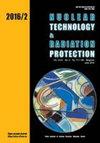严格的耐受标准对非均匀介质吸收剂量分布验证和评价的影响
IF 0.9
4区 工程技术
Q3 NUCLEAR SCIENCE & TECHNOLOGY
引用次数: 0
摘要
放射输送设备的进步增加了肿瘤放射治疗的复杂性。因此,治疗的结果以及患者的安全性在很大程度上取决于吸收剂量递送的一致性。两者都可以通过计算吸收剂量分布的综合验证系统来保证。标准方法是利用二维探测器和均匀模体,根据伽玛法对计算出的吸收剂量分布进行评价,得到测量到的剂量分布。本研究的目的是探讨容忍标准对伽玛通过率的影响。此外,还分析了异质幻影的一致性。吸收剂量计算采用摩纳哥和XiO系统。采用均匀型和半拟人型两种结构的1020个电离室探测器进行测量。用伽玛法分析了3500例患者的吸收剂量分布。在均匀幻相中,平均伽马通过率在3% / 2mm的公差范围内。对于非均质介质的测量,中等处理复杂度的小体积平均伽马通过率最高(=93.84%),而低复杂度的大体积处理的伽马通过率最低(??= 83.22%)。本文章由计算机程序翻译,如有差异,请以英文原文为准。
Impact of stringent tolerance criteria on verification of absorbed dose distributions and evaluation through inhomogeneous media
Advances of radiation delivery devices have increased the complexity of the radiation oncology treatments. Herewith, outcome of the treatment, as well as patient safety, strongly depend on the consistency of absorbed dose delivery. Both can be ensured by comprehensive system of verification of calculated absorbed dose distributions. Standard method is evaluation of calculated absorbed dose distribution according to gamma method, using a 2-D detector and a homogeneous phantom, to obtain measured dose distribution. Purpose of this research was to investigate the influence of tolerance criteria on gamma passing rate. Additionally, the agreement in heterogeneous phantom was analysed. Absorbed dose calculations were performed using systems Monaco and XiO. Detector with 1020 ionization chambers in homogeneous phantom and semi-anthropomorphic phantom was used for measurements. Absorbed dose distributions of around 3500 patients were analysed using gamma method. In homogeneous phantom, average gamma passing rates were within tolerance for 3 %/2 mm. For measurements in heterogeneous media, the highest average gamma passing rate was obtained for small volumes of medium treatment complexity (??=93.84%), while large volumes of treatment with low complexity yielded the lowest gamma passing rates (??= 83.22%).
求助全文
通过发布文献求助,成功后即可免费获取论文全文。
去求助
来源期刊

Nuclear Technology & Radiation Protection
NUCLEAR SCIENCE & TECHNOLOGY-
CiteScore
2.00
自引率
41.70%
发文量
10
审稿时长
6-12 weeks
期刊介绍:
Nuclear Technology & Radiation Protection is an international scientific journal covering the wide range of disciplines involved in nuclear science and technology as well as in the field of radiation protection. The journal is open for scientific papers, short papers, review articles, and technical papers dealing with nuclear power, research reactors, accelerators, nuclear materials, waste management, radiation measurements, and environmental problems. However, basic reactor physics and design, particle and radiation transport theory, and development of numerical methods and codes will also be important aspects of the editorial policy.
 求助内容:
求助内容: 应助结果提醒方式:
应助结果提醒方式:


